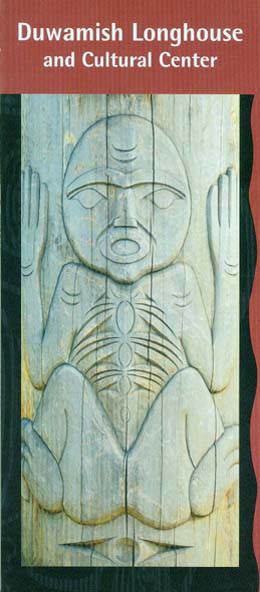On January 3, 2009, members and descendants of Seattle's First People, the Duwamish Tribe, held a Grand Opening ceremony at their beautiful new Duwamish Longhouse and Cultural Center (4705 West Marginal Way SW), which is situated at a traditional riverside village site.
History and Struggle for Recognition
The Duwamish (Dkhw’Duw’Absh) Tribe had enjoyed living and fishing in the Puget Sound area and along the Duwamish River Valley for many centuries prior to the arrival of white settlers in the mid-nineteenth century. In 1851 the Duwamish people -- and Chief Si'ahl or Si'at (aka Chief "Seattle," sometimes mis-stated as "Sealth") -- welcomed the arrival of the Alki landing party. This group comprising the Denny, Low, Bell, Boren, and Terry parties proceeded to found the city named in honor of the beneficent chief.
But as ever more newcomers arrived seeking land for homesteads, the Natives -- who had willingly provided the struggling newcomers with fish and other survival basics -- were shunted aside. Between 1855 and 1904, 94 traditional Duwamish longhouses were burned to the ground, according to tribal historian Thomas R. Speer. It was Seattle co-founder Charles Terry (1828-1867) who reportedly led an effort to raze the tribe's ancient village (hah-AH-poos), which was located along the banks of the Duwamish River at a site (which has been dated archeologically to 300 BCE, and is listed on the National Register of Historic Places), just east of the new center.
For many decades, the Duwamish Tribe has struggled to gain federal recognition from the United States federal government. On January 19, 2001, that official recognition was finally granted under Bill Clinton’s administration, only to be reversed within hours of the new Bush administration assuming power. But through it all, the Duwamish Tribe has made heroic efforts to preserve and revitalize its culture. The tribe continues to seek federal recognition.
The Opening Ceremony
After more than three decades of active planning and fundraising, the new Duwamish $4 million facility is a physical testament to the 570-member tribe’s ability to endure, persevere, and accomplish great things. The nearly four-hour opening ceremony itself served as way to announce that the tribe is here to stay -- and to acknowledge and thank many of the friends and benefactors of the project.
To a backdrop of tribal drumming, and a traditional feast of smoked salmon, attendees were honored to witness tribal elders, and Longhouse Director James Rasmussen, offering profuse words of thanks and generous gifts (blankets, etc.) to numerous longtime supporters, including the Friends of the Duwamish organization and the Descendants' Committee. Co-chair of the project's Fundraising Committee, Chad Lewis (great-great-grandson of settler Charles Terry), has worked tirelessly to raise the funds needed to make this new cultural home a reality.
The Duwamish Longhouse
The 6,044-square-foot facility itself was designed by Byron Barnes of Potlatch Architects and constructed in a form reminiscent of a traditional wooden longhouse. The main room features a two-story ceiling supported by four massive vertical posts that will eventually be carved into "story poles," and traditional tiered-bench-style seating.
The center includes a kitchen, a gift shop, a display area that currently features the stunningly crafted baskets of Mary Lou Slaughter (another descendant of Chief Si'ahl), and educational historical exhibits. It will function as the Duwamish Tribe's business office, and as a rentable venue for various community events.

